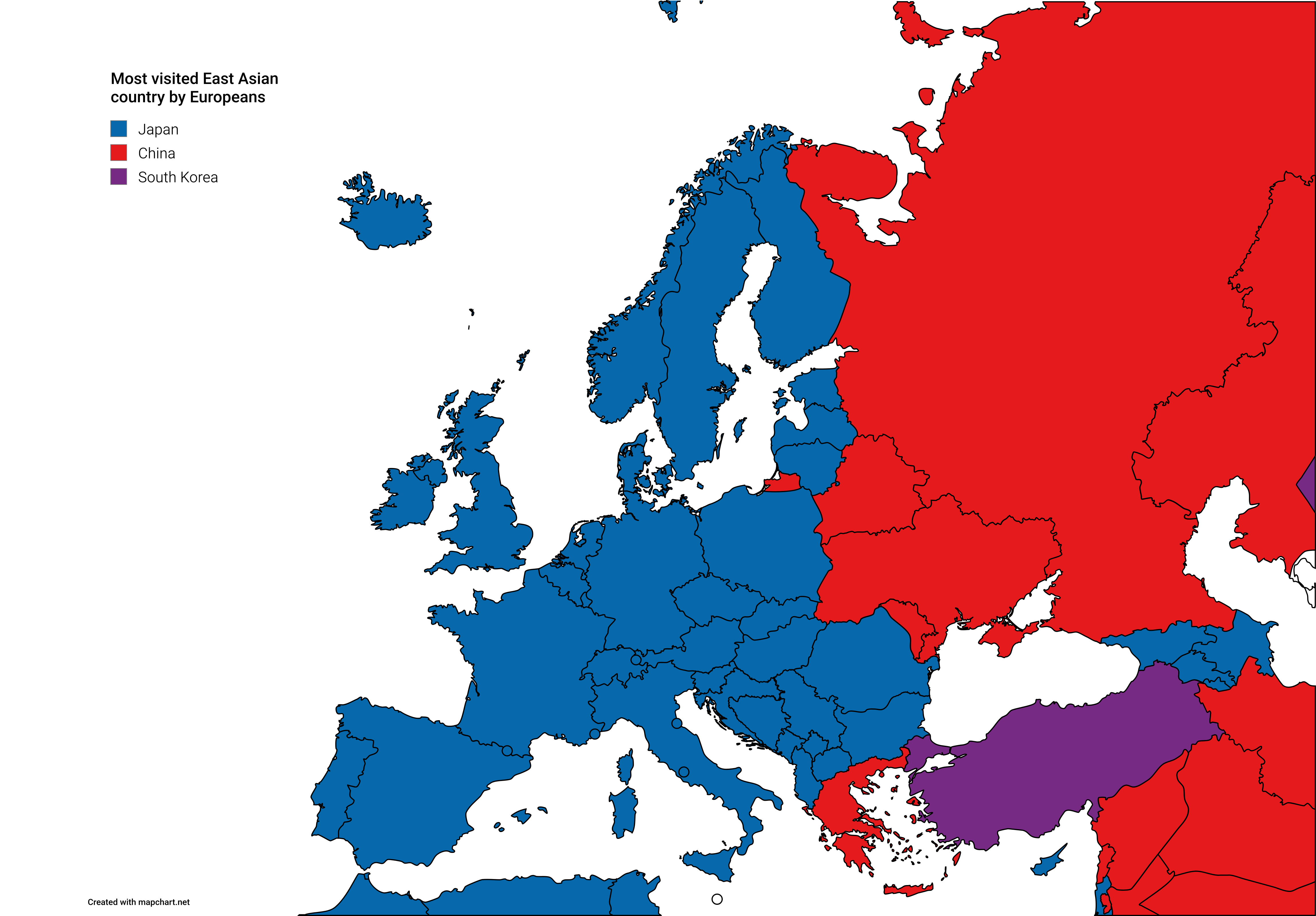Map of Most Visited East Asian Countries by Europeans


Marcus Rodriguez
Historical Geography Expert
Marcus Rodriguez specializes in historical cartography and geographic data analysis. With a background in both history and geography, he brings unique...
Geographic Analysis
What This Map Shows
The visualization titled 'Most Visited East Asian Countries by Europeans' presents an insightful look into travel patterns and preferences of European tourists within the East Asian region. This map highlights the countries in East Asia that attract the highest number of visitors from Europe, showcasing a vibrant exchange of culture, business, and tourism. Each country on the map is color-coded to indicate the volume of visitors, enabling a quick understanding of which nations are the most popular among European travelers.
Transitioning from the map itself, let’s delve into the specifics of travel patterns and the underlying factors that influence these preferences.
Deep Dive into Travel Patterns in East Asia
Travel is often a reflection of economic ties, cultural interests, and historical connections. In the case of East Asia, countries like Japan, China, and South Korea consistently emerge as the most visited destinations by Europeans.
Japan, for instance, has seen a significant uptick in European visitors due to its unique blend of traditional culture and modern innovation. The allure of historical sites such as Kyoto's temples and the bustling streets of Tokyo cater to diverse interests, making it a hotspot for travelers. According to data from the Japan National Tourism Organization, there was a record of over 2.5 million visitors from Europe in 2019, before the pandemic. This interest is not just limited to major cities; rural areas, too, are gaining attention as travelers seek authentic experiences.
Conversely, China, with its rich history and vast landscapes, draws a different demographic of European travelers. The Great Wall, the Terracotta Army, and the vibrant markets of cities like Beijing and Shanghai are significant attractions. However, travel to China can be influenced by geopolitical relations and travel advisories, which have fluctuated in recent years. Interestingly, despite these challenges, China remains a popular destination, with the number of European visitors steadily increasing, reaching about 1.6 million in 2019.
South Korea, on the other hand, has gained fame through the global phenomenon of K-pop and its unique pop culture. Cities like Seoul attract younger Europeans who are eager to experience the latest trends in fashion, technology, and entertainment. The Korea Tourism Organization reported that in 2019, around 700,000 Europeans visited South Korea, a figure that shows a promising trajectory for future growth.
Regional Analysis
Examining the map, you can see distinct patterns emerge in the numbers of visitors across different East Asian countries. Japan stands out as the clear favorite among European travelers, accounting for a significant portion of visits. This preference can be attributed to Japan's comprehensive tourism marketing and its ability to cater to various interests, from culinary tourism to historical exploration.
China, while also popular, shows a more complex travel pattern influenced by political relations and travel restrictions. Some European countries maintain strong diplomatic ties with China, facilitating easier travel, while others experience hesitancy due to ongoing geopolitical tensions. This dynamic is crucial for understanding the fluctuations in visitor numbers.
South Korea's rise in popularity can be attributed to its cultural exports, especially in music and television. The 'Korean Wave' has not only attracted tourists but also business investments, creating a more interconnected relationship with Europe. Other countries in the region, such as Taiwan and Hong Kong, also show promise but remain overshadowed by their larger neighbors. For example, Taiwan has seen an increase in visitors, thanks to its culinary landscape and natural beauty, but it still lacks the visitor numbers that Japan or China command.
Significance and Impact
Understanding travel patterns to East Asia is significant for several reasons. First, it highlights the interconnectedness of global economies. Tourism is a major economic driver for many East Asian countries, and knowing where visitors are coming from helps to tailor services and marketing strategies effectively.
Moreover, the cultural exchange that occurs through tourism enriches both the visitors and the host countries. European travelers often return home with a newfound appreciation for East Asian cultures, fostering goodwill and a deeper understanding between regions.
As we look to the future, the impact of the COVID-19 pandemic on travel patterns cannot be understated. While countries are beginning to recover, the long-term effects on tourism trends could reshape preferences and priorities. Interestingly, many travel experts suggest that European visitors will increasingly seek out more sustainable and immersive travel experiences, which could benefit lesser-known destinations in East Asia.
In conclusion, the map not only serves as a geographical representation of travel but also opens discussions about cultural interactions, economic implications, and future trends in global tourism. As travel resumes and evolves, keeping an eye on these patterns will be crucial for stakeholders in the tourism industry as they adapt to a changing landscape.
Visualization Details
- Published
- September 20, 2025
- Views
- 68
Comments
Loading comments...